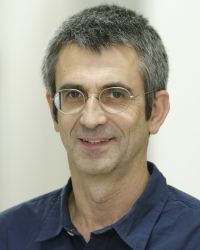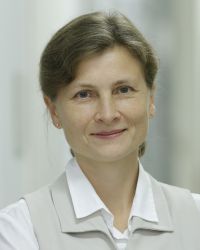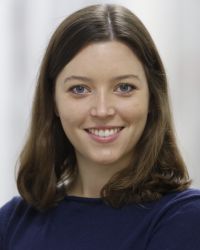SUMO Signaling
Ubiquitin and Ubiquitin-like protein modification systems control a wide variety of cellular key processes. Our laboratory is studying mechanistic and functional aspects of the Ubiquitin-like SUMO system in mammalian cells. SUMO (Small Ubiquitin-like Modifier) functions as a post-translational modifier that is covalently attached to lysine residues of target proteins. Human cells express three SUMO forms, which are conjugated in a pathway that requires the E1 activating enzyme Aos1/Uba2, the E2 conjugating enzyme Ubc9 and in many cases involves E3 SUMO ligases.
SUMO modification is a dynamic, reversible process, in which the demodification of a given SUMO-conjugate is catalyzed by SUMO-specific proteases of the SENP family.
SUMO conjugation/deconjugation typically modulates protein-protein interactions thereby controlling cellular key pathways, including gene expression programs, ribosome biogenesis, mitotic progression or genomic integrity.
Signaling by SUMO generally relies on the recognition of a modified protein by a binding partner that contains a specialized SUMO binding module termed SUMO interaction motif (SIM).
However, a detailed understanding of SUMO function in most pathways is still incomplete because the relevant targets of modification and the corresponding SUMO-dependent binding partners have not been identified. In our work we therefore want to pinpoint the critical targets of SUMO in selected cellular pathways and aim to understand the dynamics of SUMO/SIM interactions.
Prof. Dr. Stefan Müller
Gina Gotthardt
Gina Gotthardt studied Biochemistry (B. Sc. and M. Sc) at the Goethe University Frankfurt and obtained her degree in 2021. In her Master´s thesis she studied the role of ZC3H14 in mRNA export and nuclear splicing surveillance. In December 2021, Gina started to do her PhD in the lab of Stefan Müller at the IBC2 in Frankfurt to characterize and target RNF4 functions in tumors, using PROTAC technology.
Jan Keiten-Schmitz
Dr. Luca Mendler
Paul Hotz
Tabea Stark
Tabea obtained her bachelor’s degree in Biochemistry in 2019 at the Goethe University in Frankfurt am Main. For her bachelor’s thesis, she joined the lab of Prof. Dr. Zoltán Ivics, where she worked on CRISPR/Cas9-mediated gene editing of snRNP70.
She then enrolled in the Master’s program in Molecular Medicine at the Goethe University in Frankfurt am Main. In 2021, she began her master’s thesis in the lab of Prof. Dr. Stefan Müller at the Institute of Biochemistry II. Her research focused on nuclear protein quality control pathways where she aimed to understand the implication of the nucleolus and the SUMO/ubiquitin-network in maintaining cellular proteostasis.
After completing her master’s degree, she continued her work on nuclear protein quality control by starting her PhD in the Müller lab in July 2022.
Dr. Upayan Patra
Upayan completed his Ph.D. in the field of molecular virology in 2021 from Indian Council of Medical Research-National Institute of Cholera and Enteric Diseases (ICMR-NICED), Kolkata, India. His doctoral research work revolved around dissecting host-virus interactions on high throughput platforms to yield targets and pathways which are either beneficial or detrimental to viral propagation and therefore subject to therapeutic interventions. He moved to Frankfurt in 2021 to join the Müller lab for pursuing post-doctoral research in SUMO signaling under various pathological settings.
Past Members:
Hannah Mende

Judith Dönig
Judith Dönig was born in Frankfurt and studied Biosciences (B.Sc.) and Molecular Biosciences (M.Sc) at the Goethe-University in Frankfurt. In her master thesis she studied the alanine- and formate- metabolism of the acetogenic bacterium Acetobacterium woodii. She has been part of the Müller group as a PhD student since April 2019 and focusses on the characterization of the SUMO-specific isopeptidase SENP5.
Papain-like protease regulates SARS-CoV-2 viral spread and innate immunity.
Shin D, Mukherjee R, Grewe D, Bojkova D, Baek K, Bhattacharya A, Schulz L, Widera M, Mehdipour AR, Tascher G, Geurink PP, Wilhelm A, van der Heden van Noort GJ, Ovaa H, Müller S, Knobeloch KP, Rajalingam K, Schulman BA, Cinatl J, Hummer G, Ciesek S, Dikic I.
Nature. 2020 Nov;587(7835):657-662. doi: 10.1038/s41586-020-2601-5. Epub 2020 Jul 29.
PMID: 32726803 Link
Vitamin K antagonism impairs the bone marrow microenvironment and hematopoiesis.
Verma D, Kumar R, Pereira RS, Karantanou C, Zanetti C, Minciacchi VR, Fulzele K, Kunz K, Hoelper S, Zia-Chahabi S, Jabagi MJ, Emmerich J, Dray-Spira R, Kuhlee F, Hackmann K, Schroeck E, Wenzel P, Müller S, Filmann N, Fontenay M, Pajevic PD, Krause DS.Blood. 2019 Jul 18;134(3):227-238. doi: 10.1182/blood.2018874214. Epub 2019 Apr 19.PMID: 31003999 Free PMC article. Link
Full length RTN3 regulates turnover of tubular endoplasmic reticulum via selective autophagy.
Grumati P, Morozzi G, Hölper S, Mari M, Harwardt MI, Yan R, Müller S, Reggiori F, Heilemann M, Dikic I.Elife. 2017 Jun 15;6:e25555. doi: 10.7554/eLife.25555.PMID: 28617241 Link
Multiplex image-based autophagy RNAi screening identifies SMCR8 as ULK1 kinase activity and gene expression regulator.
Jung J, Nayak A, Schaeffer V, Starzetz T, Kirsch AK, Müller S, Dikic I, Mittelbronn M, Behrends C.Elife. 2017 Feb 14;6:e23063. doi: 10.7554/eLife.23063.PMID: 28195531 Link
Inhibition of MLL1 histone methyltransferase brings the developmental clock back to naïve pluripotency.
Muller S, Nayak A.Stem Cell Investig. 2016 Oct 20;3:58. doi: 10.21037/sci.2016.09.14. eCollection 2016.PMID: 27868040 Link
Gotthardt G, Keiten-Schmitz J, Müller S Reprogramming SUMO-primed ubiquitylation: opportunities in oncology and neurology. Trends Pharmacol Sci 2025. 46 (11) 1117-1129 Link
Wagner K, Keiten-Schmitz J, Adhikari B, Patra U, Husnjak K, McNicoll F, Dormann D, Müller-McNicoll M, Tascher G, Wolf E, Müller S Induced proximity to PML protects TDP-43 from aggregation via SUMO-ubiquitin networks. Nat Chem Biol 2025. 21 (9) 1408-1419 Link
Kowald L, Roedig J, Karlowitz R, Wagner K, Smith S, Juretschke T, Beli P, Müller S, van Wijk SJL USP22 regulates APL differentiation via PML-RARα stabilization and IFN repression. Cell Death Discov 2024. 10 (1) 128 Link
Dönig J, Mende H, Davila Gallesio J, Wagner K, Hotz P, Schunck K, Piller T, Hölper S, Uhan S, Kaulich M, Wirth M, Keller U, Tascher G, Bohnsack KE, Müller S Characterization of nucleolar SUMO isopeptidases unveils a general p53-independent checkpoint of impaired ribosome biogenesis. Nat Commun 2023. 14 (1) 8121 Link
Zhang L, Wirth M, Patra U, Stroh J, Isaakidis K, Rieger L, Kossatz S, Milanovic M, Zang C, Demel U, Keiten-Schmitz J, Wagner K, Steiger K, Rad R, Bassermann F, Müller S, Keller U, Schick M Actionable loss of SLF2 drives B-cell lymphomagenesis and impairs the DNA damage response. EMBO Mol Med 2023. 15 (9) e16431 Link
Demel UM, Wirth M, Yousefian S, Zhang L, Isaakidis K, Dönig J, Böger M, Singh N, Köse H, Haas S, Müller S, Schick M, Keller U Small-molecule SUMO inhibition for biomarker-informed B-cell lymphoma therapy. Haematologica 2023. 108 (2) 555-567 Link
Heynen GJJE, Baumgartner F, Heider M, Patra U, Holz M, Braune J, Kaiser M, Schäffer I, Bamopoulos SA, Ramberger E, Murgai A, Ng YLD, Demel UM, Laue D, Liebig S, Krüger J, Janz M, Nogai A, Schick M, Mertins P, Müller S, Bassermann F, Krönke J, Keller U, Wirth M, et al. SUMOylation inhibition overcomes proteasome inhibitor resistance in multiple myeloma. Blood Adv 2023. 7 (4) 469-481 Link
Demel UM, Böger M, Yousefian S, Grunert C, Zhang L, Hotz PW, Gottschlich A, Köse H, Isaakidis K, Vonficht D, Grünschläger F, Rohleder E, Wagner K, Dönig J, Igl V, Brzezicha B, Baumgartner F, Habringer S, Löber J, Chapuy B, Weidinger C, Kobold S, Haas S, Busse AB, Müller S, et al. Activated SUMOylation restricts MHC class I antigen presentation to confer immune evasion in cancer. J Clin Invest 2022. 132 (9) Link
Schick M, Zhang L, Maurer S, Maurer HC, Isaakaidis K, Schneider L, Patra U, Schunck K, Rohleder E, Hofstetter J, Baluapuri A, Scherger AK, Slotta-Huspenina J, Hettler F, Weber J, Engleitner T, Maresch R, Slawska J, Lewis R, Istvanffy R, Habringer S, Steiger K, Baiker A, Oostendorp RAJ, Miething C, et al. Genetic alterations of the SUMO isopeptidase SENP6 drive lymphomagenesis and genetic instability in diffuse large B-cell lymphoma. Nat Commun 2022. 13 (1) 281 Link
Hotz PW, Müller S, Mendler L SUMO-specific Isopeptidases Tuning Cardiac SUMOylation in Health and Disease. Front Mol Biosci 2021. 8 786136 Link
Patra U, Müller S A Tale of Usurpation and Subversion: SUMO-Dependent Integrity of Promyelocytic Leukemia Nuclear Bodies at the Crossroad of Infection and Immunity. Front Cell Dev Biol 2021. 9 696234 Link
Keiten-Schmitz J, Röder L, Hornstein E, Müller-McNicoll M, Müller S SUMO: Glue or Solvent for Phase-Separated Ribonucleoprotein Complexes and Molecular Condensates? Front Mol Biosci 2021. 8 673038 Link
Hotz PW, Wiesnet M, Tascher G, Braun T, Müller S, Mendler L Profiling the Murine SUMO Proteome in Response to Cardiac Ischemia and Reperfusion Injury. Molecules 2020. 25 (23) Link
Keiten-Schmitz J, Wagner K, Piller T, Kaulich M, Alberti S, Müller S The Nuclear SUMO-Targeted Ubiquitin Quality Control Network Regulates the Dynamics of Cytoplasmic Stress Granules. Mol Cell 2020. 79 (1) 54-67.e7 Link
Biederstädt A, Hassan Z, Schneeweis C, Schick M, Schneider L, Muckenhuber A, Hong Y, Siegers G, Nilsson L, Wirth M, Dantes Z, Steiger K, Schunck K, Langston S, Lenhof HP, Coluccio A, Orben F, Slawska J, Scherger A, Saur D, Müller S, Rad R, Weichert W, Nilsson J, Reichert M, et al. SUMO pathway inhibition targets an aggressive pancreatic cancer subtype. Gut 2020. 69 (8) 1472-1482 Link
Keiten-Schmitz J, Schunck K, Müller S SUMO Chains Rule on Chromatin Occupancy. Front Cell Dev Biol 2019. 7 343 Link
Wagner K, Kunz K, Piller T, Tascher G, Hölper S, Stehmeier P, Keiten-Schmitz J, Schick M, Keller U, Müller S The SUMO Isopeptidase SENP6 Functions as a Rheostat of Chromatin Residency in Genome Maintenance and Chromosome Dynamics. Cell Rep 2019. 29 (2) 480-494.e5 Link
Kunz K, Müller S, Mendler L Assays of SUMO protease/isopeptidase activity and function in mammalian cells and tissues. Methods Enzymol 2019. 618 389-410 Link
Gärtner A, Wagner K, Hölper S, Kunz K, Rodriguez MS, Müller S Acetylation of SUMO2 at lysine 11 favors the formation of non-canonical SUMO chains. EMBO Rep 2018. 19 (11) Link
Kunz K, Piller T, Müller S SUMO-specific proteases and isopeptidases of the SENP family at a glance. J Cell Sci 2018. 131 (6) Link
Wiechmann S, Gärtner A, Kniss A, Stengl A, Behrends C, Rogov VV, Rodriguez MS, Dötsch V, Müller S, Ernst A Site-specific inhibition of the small ubiquitin-like modifier (SUMO)-conjugating enzyme Ubc9 selectively impairs SUMO chain formation. J Biol Chem 2017. 292 (37) 15340-15351 Link
Nayak A, Reck A, Morsczeck C, Müller S Flightless-I governs cell fate by recruiting the SUMO isopeptidase SENP3 to distinct genes. Epigenetics Chromatin 2017. 10 15 Link
Raman N, Weir E, Müller S The AAA ATPase MDN1 Acts as a SUMO-Targeted Regulator in Mammalian Pre-ribosome Remodeling. Mol Cell 2016. 64 (3) 607-615 Link
Husnjak K, Keiten-Schmitz J, Müller S Identification and Characterization of SUMO-SIM Interactions. Methods Mol Biol 2016. 1475 79-98 Link
Kunz K, Wagner K, Mendler L, Hölper S, Dehne N, Müller S SUMO Signaling by Hypoxic Inactivation of SUMO-Specific Isopeptidases. Cell Rep 2016. 16 (11) 3075-3086 Link
Mendler L, Braun T, Müller S The Ubiquitin-Like SUMO System and Heart Function: From Development to Disease. Circ Res 2016. 118 (1) 132-44 Link
Nayak A, Müller S SUMO-specific proteases/isopeptidases: SENPs and beyond. Genome Biol 2014. 15 (7) 422 Link
Raman N, Nayak A, Muller S mTOR signaling regulates nucleolar targeting of the SUMO-specific isopeptidase SENP3. Mol Cell Biol 2014. 34 (24) 4474-84 Link
Gärtner A, Muller S PML, SUMO, and RNF4: guardians of nuclear protein quality. Mol Cell 2014. 55 (1) 1-3 Link
Nayak A, Viale-Bouroncle S, Morsczeck C, Muller S The SUMO-specific isopeptidase SENP3 regulates MLL1/MLL2 methyltransferase complexes and controls osteogenic differentiation. Mol Cell 2014. 55 (1) 47-58 Link
Raman N, Nayak A, Muller S The SUMO system: a master organizer of nuclear protein assemblies. Chromosoma 2013. 122 (6) 475-85 Link
Ullmann R, Chien CD, Avantaggiati ML, Muller S An acetylation switch regulates SUMO-dependent protein interaction networks. Mol Cell 2012. 46 (6) 759-70 Link
Finkbeiner E, Haindl M, Raman N, Muller S SUMO routes ribosome maturation. Nucleus 2011. 2 (6) 527-32 Link
van Wijk SJ, Müller S, Dikic I Shared and unique properties of ubiquitin and SUMO interaction networks in DNA repair. Genes Dev 2011. 25 (17) 1763-9 Link
Finkbeiner E, Haindl M, Muller S The SUMO system controls nucleolar partitioning of a novel mammalian ribosome biogenesis complex. EMBO J 2011. 30 (6) 1067-78 Link
Jentsch S, Müller S Regulatory Functions of Ubiquitin and SUMO in DNA Repair Pathways. Subcell Biochem 2010. 54 184-94 Link
Messner S, Schuermann D, Altmeyer M, Kassner I, Schmidt D, Schär P, Müller S, Hottiger MO Sumoylation of poly(ADP-ribose) polymerase 1 inhibits its acetylation and restrains transcriptional coactivator function. FASEB J 2009. 23 (11) 3978-89 Link
Stehmeier P, Muller S Phospho-regulated SUMO interaction modules connect the SUMO system to CK2 signaling. Mol Cell 2009. 33 (3) 400-9 Link
Stehmeier P, Muller S Regulation of p53 family members by the ubiquitin-like SUMO system. DNA Repair (Amst) 2009. 8 (4) 491-8 Link
Klein UR, Haindl M, Nigg EA, Muller S RanBP2 and SENP3 function in a mitotic SUMO2/3 conjugation-deconjugation cycle on Borealin. Mol Biol Cell 2009. 20 (1) 410-8 Link
Muller S, Dobner T The adenovirus E1B-55K oncoprotein induces SUMO modification of p53. Cell Cycle 2008. 7 (6) 754-8 Link
Haindl M, Harasim T, Eick D, Muller S The nucleolar SUMO-specific protease SENP3 reverses SUMO modification of nucleophosmin and is required for rRNA processing. EMBO Rep 2008. 9 (3) 273-9 Link
Mziaut H, Trajkovski M, Kersting S, Ehninger A, Altkrüger A, Lemaitre RP, Schmidt D, Saeger HD, Lee MS, Drechsel DN, Müller S, Solimena M Synergy of glucose and growth hormone signalling in islet cells through ICA512 and STAT5. Nat Cell Biol 2006. 8 (5) 435-45 Link
Bossis G, Malnou CE, Farras R, Andermarcher E, Hipskind R, Rodriguez M, Schmidt D, Muller S, Jariel-Encontre I, Piechaczyk M Down-regulation of c-Fos/c-Jun AP-1 dimer activity by sumoylation. Mol Cell Biol 2005. 25 (16) 6964-79 Link
Ledl A, Schmidt D, Müller S Viral oncoproteins E1A and E7 and cellular LxCxE proteins repress SUMO modification of the retinoblastoma tumor suppressor. Oncogene 2005. 24 (23) 3810-8 Link
Trajkovski M, Mziaut H, Altkrüger A, Ouwendijk J, Knoch KP, Müller S, Solimena M Nuclear translocation of an ICA512 cytosolic fragment couples granule exocytosis and insulin expression in {beta}-cells. J Cell Biol 2004. 167 (6) 1063-74 Link
Müller S, Ledl A, Schmidt D SUMO: a regulator of gene expression and genome integrity. Oncogene 2004. 23 (11) 1998-2008 Link
García-Estrada C, Reguera RM, Villa H, Requena JM, Müller S, Pérez-Pertejo Y, Balaña-Fouce R, Ordóñez D Identification of a gene in Leishmania infantum encoding a protein that contains a SP-RING/MIZ zinc finger domain. Biochim Biophys Acta 2003. 1629 (1-3) 44-52 Link
Netzer C, Bohlander SK, Rieger L, Müller S, Kohlhase J Interaction of the developmental regulator SALL1 with UBE2I and SUMO-1. Biochem Biophys Res Commun 2002. 296 (4) 870-6 Link
Kirsh O, Seeler JS, Pichler A, Gast A, Müller S, Miska E, Mathieu M, Harel-Bellan A, Kouzarides T, Melchior F, Dejean A The SUMO E3 ligase RanBP2 promotes modification of the HDAC4 deacetylase. EMBO J 2002. 21 (11) 2682-91 Link
Schmidt D, Müller S Members of the PIAS family act as SUMO ligases for c-Jun and p53 and repress p53 activity. Proc Natl Acad Sci U S A 2002. 99 (5) 2872-7 Link
Signaling by SUMO relies on the recognition of the post-translational mark by specialized interaction modules termed SUMO interaction motifs (SIMs). SUMO-mediated protein/protein interactions are frequently mediated by the non-covalent binding of SUMO conjugates to SIMs in a binding partner.
A common key determinant of SIMs is a core of hydrophobic amino acids. In a subset of SIM-containing proteins, including members of the PIAS (Protein inhibitor of activated STAT) family, this hydrophobic core is flanked by serine residues and a stretch of acidic residues. By using PIAS1 as a SUMO-binding model protein we could previously show that these serine residues are phosphorylated by the kinase CK2 and could demonstrate that this dictates binding of free SUMO and SUMO conjugates to PIAS1 (Stehmeier and Muller, 2009).
CK2-regulated phosphoSIM modules were also dissected in the tumor suppressor PML and the exosome component PMSCL1, indicating that these modules serve as general platforms that integrate CK2- and SUMO-regulated signaling networks. The characterization of SIMs in PIAS and PML revealed a new regulatory layer for SUMO recognition by SIM modules. One aspect of our current project is to functionally characterize the phosphoSIM modules of PIAS family members.
Moreover, we aim to elucidate other mechanisms that regulate the dynamics of SUMO/SIM interactions and want to understand how this affects specific cellular pathways, in particular PIAS-mediated transcriptional processes.
Stehmeier, P. & Muller, S. (2009). Phospho-regulated SUMO interaction modules connect the SUMO system to CK2 signaling. Mol. Cell 33, 400-409.
Ribosome biogenesis is a tightly controlled pathway that requires an intricate spatial and temporal interplay of protein networks. Most structural rRNA components are generated in the nucleolus and assembled into pre-ribosomal particles, which are transferred for further maturation to the nucleoplasm and cytoplasm. In mammalian cells, however, it is largely unclear what drives these processes.
Our previous and current work revealed a critical role for the SUMO-specific protease SENP3 in the control of nucleolar dynamics and ribosome biogenesis. In particular, we could show that SENP3 is critically involved in the maturation of the 28S rRNA and the nucleolar export of the 60S pre-ribosomal subunit (Haindl et al., 2008, Finkbeiner et al., 2011). We now identified and characterized a novel SENP3-associated complex comprised of PELP1, TEX10 and WDR18 and demonstrate that this complex is involved in maturation and nucleolar release of the large ribosomal subunit. We identified PELP1 and as a SENP3-sensitive targets of SUMO2 and provide evidence that the SUMO system determines the nucleolar partitioning of the PELP1-TEX10-WDR18 complex.
This work thus defines the PELP1-TEX10-WDR18 complex as a novel regulator of ribosome biogenesis and suggests that its SUMO-regulated distribution provides a mechanism to coordinate the rate of ribosome formation. We propose a model where the balanced SUMO conjugation/deconjugation controls the dynamic association of this complex with 60S pre-ribosomal particles. We now aim to get mechanistic insights how sumoylation/desumoylation processes mediate the dynamics of pre-60S pre-ribosomal particles. Moreover, we want to understand how the SUMO system coordinates the rate of ribosome formation with the physiological state of the cell.
Haindl, M., Harasim, T., Eick, D. & Muller, S. (2008). The nucleolar SUMO-specific protease SENP3 reverses SUMO modification of nucleophosmin and is required for rRNA processing. EMBO Rep. 9, 273-279.
Finkbeiner, E., Haindl, M. & Muller S. (2011) The SUMO system controls nucleolar partitioning of a novel mammalian ribosome biogenesis complex. EMBO J., 30, 1067 – 1078.
Institute of Biochemistry II
University Hospital Frankfurt
Goethe University
Theodor-Stern-Kai 7 / Building 75
60590 Frankfurt am Main
Germany
Tel (office): +49 (0) 69 6301 83647
Tel (lab): +49 (0) 69 6301 5569
Fax: +49 (0) 69 6301 5577
All IBCII Members Contact Data










